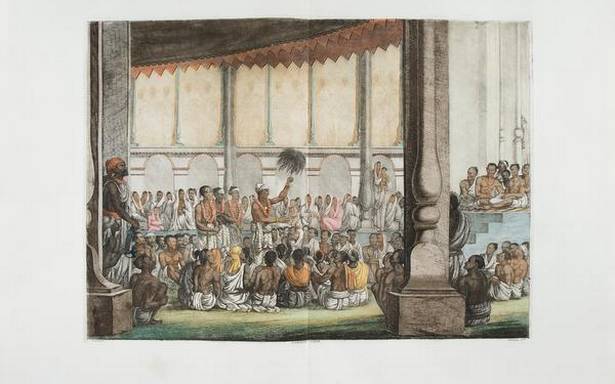In the late 17th Century, East India Company galleons sailed up the Bay of Bengal into the waterlogged delta of the Ganges-Brahmaputra and weighed anchor. Legend has it that administrator Job Charnock ‘established’ the city of Calcutta at the site of three extant villages, near the banyan tree where he liked to smoke his hubble-bubble.
Over time, Calcutta became the hub for Company trade, the capital of the sub-continent and seat of the province of Bengal. Businessmen and soldiers, artists and memsahibs, all drawn to Bengal’s riches in wealth and culture, flocked to it. Among them was Flemish marine painter, printmaker and ethnographer, Balthazar Solvyns, perhaps the only European artist to have documented the people and material culture of Bengal in the decade he lived there.
‘The whole spectrum of society’
An exhibition by DAG featuring the 288 etchings of Solvyns that he titled Les Hindous opened recently in New Delhi. The works were published by the artist in Paris between 1808 and 1812.
“What makes Solvyns exceptional, among foreign artists in India of his time, is his focus on the whole spectrum of society from high to low. Most British painters, for example, were portrait painters seeking patronage from the elites (Indian rulers, British officials etc); or they portrayed architecture and landscape (like the Daniells). Solvyns addressed Indian society as a whole, and did not neglect its less privileged members,” says Giles Tillotson, senior vice president, Exhibitions and Publications at DAG, in an email interview.
Curated by Tillotson, the exhibition is accompanied by a book that introduces, illustrates and contextualises this body of work. Tillotson who has written on Rajput, Mughal, British era and modern architecture and art, has in recent years focussed on the 18th Century and had earlier curated an exhibition based around a complete set of Oriental scenery by Thomas and William Daniell in the Red Fort.
Les Hindous can be viewed in the high-vaulted halls of Bikaner House in the heart of Lutyens’ Delhi. The paintings are of individuals and of groups, a hat tip to Calcutta’s growth as a cosmopolitan city. So while a native, dhoti-clad man blows the ramsingha (serpent horn), women in flounces and petticoats stroll through the European quarters. The colours are muted, but the exposed brickwork and colonnades are stark. At the bazaar, palm trees are in the distance as men and women crowd the baskets selling wares, but it is the different types of clothing, the drape of the sari or the dhoti, indicating caste and class, that underline Solvyns’ keen powers of survey.
“All the works are coloured etchings on paper and hence the works are rested in light and temperature-controlled environments between exhibitions,” says Tillotson, adding, “Each work in this series is based on close observation — of a person or an object such as a boat, cart, a musical instrument… It is also accompanied by text, written by the artist, describing the person or object, explaining them to Western audiences.”
The storyteller
The descriptive texts are quaint with phonetic spellings for a Parisian viewer, but they also reveal an ethnographic study of Bengal. The works also feature ‘nautch’ girls and fortune tellers apart from the gamut of weavers, boatmen and merchants, lending the portraits a touch of the exotic.
“Inevitably, the gaze is in part European. Solvyns is attracted to some things that are strange to Western eyes. Some of the ceremonies and religious rites fall in this category — like the views depicting sati or charak puja. But one also gets a strong sense of Solvyns gathering information from the people he met, his informants, particularly Bengali Brahmins.”
The series also covers carts and palanquins, apparatus for smoking and natural history.
Solvyns did not arrive in India with the intent of portraying its people to Europe. In the early years, he decorated carriages and restored paintings for a living. It opened to him a world of customs, dress and character he may not have seen otherwise. Or, neither would have we, of that India veiled now by the mists of time.
The exhibition is on till August 20 at Bikaner House, New Delhi. It can also be viewed online at https://dagworld.com/ The_Hindus/


